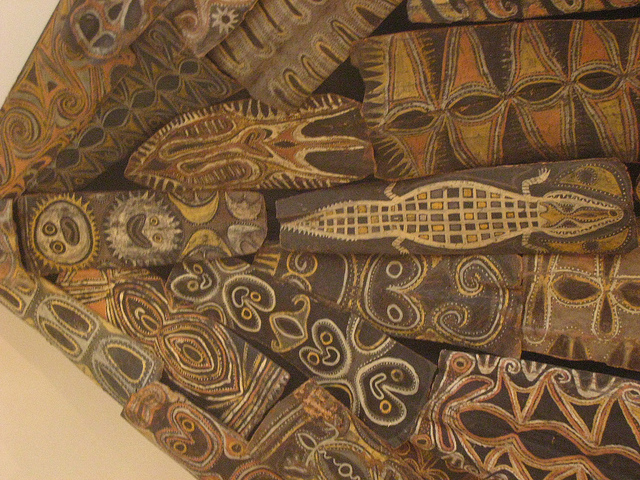
THINKING NATIVE
I don’t know if it’s just me or if it’s an artist thing to ponder frequently on the direction you want to head. (You tend to spend a lot of time making course-corrections when you’re flying by the seat of your pants, I find.)
I have been musing on this a lot lately. I think I am trying, in all my work – in my art, my poetry, my writing and even in my property management gig — to incorporate the Oceanic mindsets in which I’ve been steeped.
Oceania includes Australia, New Guinea, Melanesia, Micronesia and Polynesia. Adrienne L. Kaeppler, in her book THE PACIFIC ARTS OF POLYNESIA AND MICRONESIA postulates that the goal of Oceanic art is to produce fine art that makes Pacific themes understandable in today’s worlds.
She points out that contemporary Oceanic artists don’t slavishly copy old products or art processes. Their work is based, instead on knowledge of traditional aesthetic systems. She goes into detail, explaining this concept of hers.
THE IMPORTANCE OF YOUR AUDIENCE (CUSTOMERS)
One very real aspect of doing work that arises out of an indigenous mindset is the awareness of the importance of the audience. (For a business person, I suppose that would be your customers.)
I remember watching a friend (a sculptor of stones) looking at and appreciating the Light of My Life’s rock work.
Mat (the LOML) did a series of petroglyph carvings on rocks that he set in a spiral in the yard as a memorial for his dad who had died at the beginning of that year of carving. He was also aiming at honoring the old Hawaiians who taught him so much when he first came to the island.
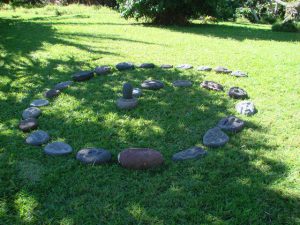
Mat’s petroglyphs basically arose out of traditional Hawaiian motifs but they are definitely not exact copies of the old stuff. Each bit is layered with a superficial theme and then deeper kaona, inner meaning, metaphor, and symbolism.
My friend Cecilia didn’t understand the cultural references at all and may not have even been aware of them, but she did appreciate that there were layers of meaning in there. Just knowing that deepened the experience of the things for her, I think.
(It could be, too, that Cecilia is particularly sensitive to stone her own self since she is a stone-carver and that also was an enriching factor.)
LAYERS AND LAYERS AND LAYERS
It’s important, I think, to remember that the layers incorporated in a work may be deep or shallow. The one looking at it brings his or her own world and views to it as well. Hmmm….
Native scholar Greg Cajete has written that in indigenous ways of thinking, we understand a thing only when we understand it with all four aspects of our being: mind, body, emotion and spirit. One of my own goals is to make art and poetry that tap into these indigenous ways of knowing….
People are affected by my poetry because they arise out of my life experiences that are mirrors of their own. Everyone has experienced loss. Everyone has experienced anger, betrayal, disappointment and pain. Everyone has experienced joy. Everyone makes decisions about the paths they will take and the ones they will not.
This is what I share with others – my own paths toward grace.
For me, the paths that lead to grace are buried in the detritus of the everyday and they are also illuminated by my own cultural understandings and mindsets.
My mission seems to have been about finding the paths and byways that resonate with me, marking them off, and trying to follow them.
MAKING THE CONNECT
As for my audience, well…I am still trying to suss that one out.
Nicholas J. Webb, a popular speaker and corporate strategist, wrote a book in 2016, WHAT CUSTOMERS CRAVE: How to Create Relevant and Memorable Experiences at Every Touchpoint.
The book has been called “insightful and pragmatic.” It should be. Webb has spent 25-plus years helping people gain insights into what their customers want. His company, Cravve, provides counseling and training in customer design and innovation for many of the world’s top brands.
This book tells you how you, too, can figure out what all those eyes that you’re trying to get to notice you are wanting to see.
In this YouTube podcast posted by CT Corporation (a subsidiary of Wulters Kluwer) as part of their business marketing “toolbox,” Webb talks about his ideas for dealing with “touch points” – the places where you connect with other people. As I listened to the podcast, it struck me that Webb’s ideas are all about making good connections. They are positively Oceanic in mindset.
(Wulters Kluwer is a multi-national information services company based in the Netherlands with operations in over 35 countries. CT Corporation is “the largest registered agent service firm in the world representing hundreds of thousands of business entities worldwide. It provides software and services that legal professionals use,” it says here.)
FINAL THOUGHTS
My audience is probably made up of the people who are trying to do the same as me, people who are trying to add mana and meaning to their own everyday lives.
I think there may be a market somewhere in all that. I just need to refine my walk so that I can connect with the people who are already working on that their own selves.
As I am learning my craft and learning more about my market, my real reward will be spending a bunch of time in what I call “Little-G World”…where I can be just like a little god, making it all up as I go along. That is a cool thing, I am thinking.
Also, I am thinking that the late, great Ray Kroc once said, “If you work just for money, you’ll never make it, but if you love what you’re doing and you always put the customer first, success will be yours.”
In WHAT CUSTOMERS CRAVE, Webb helps you figure out how to influence other people to love you for doing what you love. This, too, is a good thing…and it’s very Oceanic.
And here’s a poem:
CONNECTING THE DOTS
Art.
What is art?
Art is not a piece of work.
It is a reaching inward and a coming back.
Artist.
What is an artist?
What are artists for real if they are more than
The producers of pretty objects
Meant to cover up some wall space or match a couch.
We are the keepers.
We hold.
We are the seekers and explorers.
We go.
We are the lost ones.
We come back.
We are the messengers.
We carry the dreams.
We look forward and see what can be.
We look back and see what was.
We look outward and see illusion.
We look inward and we wonder.
We accept what-is and build from it.
We accept what-is and choose the good.
We accept what-is and work for change.
Native.
What is that?
It is a way of life,
It is a way of being.
It is a reaching forward and a coming back.
It is looking inward and looking outward.
The way of Art is the way of the Native.
It is walking in Beauty and taking it in;
It is holding the Beauty and pumping it back out.
This is Native.
This is Artist.
It is a way of being.
by Netta Kanoho
Picture credit: Oceania Boards by Karen Green via Flickr [CC BY-SA 2.0]
……
SOME OTHER POSTS TO EXPLORE:
(Click on each of the post titles below and see where it takes you…)
……
Thanks for your visit. I’d appreciate it if you’d drop a comment or note below.
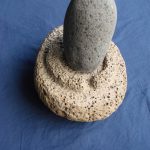
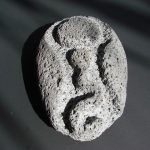



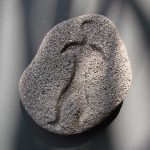



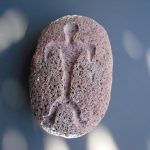
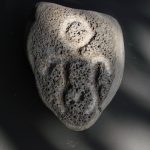


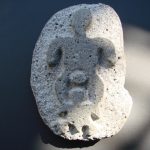





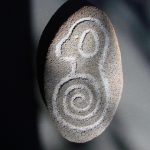



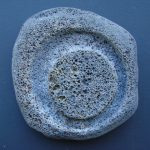
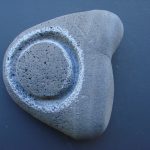
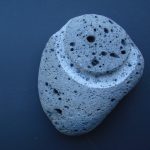
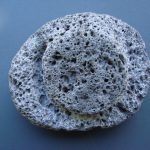
16 thoughts on “THINKING NATIVE”
Hi Netta,
I really love the way you write! I think you make some really good points about connecting with your audience, particularly in understanding the importance of your audience.
I think it’s so importance that audiences are targeted based on like-mindedness and similarities in beliefs, ideologies, passions and interests.
Great article!
Steve
Thank you for your kind words, Steve. I’m glad you stopped by to share your thoughts about audience. Please do come again!
Netta. Wow. Where to start?
As a fellow artist and searcher, I get where you’re coming from. Thinking native is not something that’s second nature to western society. But I’m glad you’re sharing with us.
It’s an interesting space you’re talking about – at the interface between spirituality and commerce. Finding your audience there. That’s something I’d like to do as well.
The petroglyphs in your post remind me of Joseph Campbell’s Hero with a Thousand Faces. As does your beautiful poem (I read it aloud, three times) reminiscent of the hero’s journey and the great importance of those willing to go beyond.
Thanks for this. Keep on keeping on. Looking forward to more.
Hey Larry: Thank you for your visit and your comments. It really is a strange space where I am trying to walk…. Thanks for pointing that one out. Please do come again!
Hi Netta,
It is a nice and pleasant reading your thoughts on poems,poetry and audience.
It brought back the days when I was studying Literature during my secondary school days.
I do not understand the meaning of the poems and poetry due to the way it was written.It took me quite a while to get a hang of it until I realised that poems and poetry is a form of art using words. I started to enjoy it.
As for bringing the message across to the right audiences, there are many important factors involved.
I agreed with you that deliver what the audiences want to hear is crucial to get their attention. It is necessary to make it interesting and benefit the audiences too.
Great sharing of thought about poems.Like your poem on your website.
Keep up the good work.
Hey David:
Thanks for your visit and your thoughts and comments. I do appreciate them. Please do come again….
Ray Kroc is 100% right: people who only work towards financial goals seldom make it in life. You really have to love what you and try to help your audience (or customers) by doing the thing you would love to do, even if you would not get any financial compensation for that.
There is a market for (almost) everything and the only way you can be sure you are doing great work, is by doing what you love. I know some people might disagree with me here, but that is how I experienced it in my life.
Whenever I was chasing the money, I not only was unsatisfied, but also the work I did was at best mediocre.
Hey Phil:
Thanks for your visit and for sharing your thoughts. You know…the same thing has happened to me (more times than I like to think about).
Mediocrity does seem to be the result when you are paid very well for doing stuff you’re good at but you don’t like. Everything else in your life sort of turns to cold, gunky oatmeal-beige and drowns out the sparkle.
It feels better when you go for the rainbows. (Legend says the gold hangs around with the rainbows so you’re more likely to fall into it if you do that, it seems to me.)
Please do come again.
Wow! Thanks for this insightful writeup. I enjoyed reading your opinion about audience, poems and poetry.
I’ve always had issues understanding poems, until recently (I don’t know what changed though).
Audiences are people of like-mind and funny enough, they always want to know what’s next in your bag. If one priotizes money more than the audience, you tend to lose both.
Regards!
Jordan, thanks for your visit and for sharing your thoughts.
I do agree…prioritizing money more than audience does tend to make you lose both. And, very often, whatever you do just for money may not be what you really want to be doing. Loser move, I say.
Please do come again….
Hello Netta!
That is a super duper amazing poem you have there. I so much love the lines as it really lifted my soul.
I also keep pondering on the direction I want to head and sometimes I just drop it off and hope for the best. I hope to see more of these amazing and soul-lifting lines.
Thanks
Thanks for the visit and for sharing your thoughts, caro. I am pleased you enjoyed the post.
I do agree that sometimes all this thinking, thinking, thinking does get a bit wearisome. Sometimes, the best you can do is just let go and hope for the best.
Please do come again.
Hi there and thank you for this what I will call a master piece of art.
Connecting with your audience is an awesome gift. I couldn’t stop reading, especially when I could find myself connecting with article.
I have always seen myself as a native person. Closing my eyes and seeing myself next to the oceans and on the native hills in my village as a read through.
The connection is out of this world. takes me back down memory lane to my primary and secondary school days of poems and poetry. Thank you
Akumendoh, I am so pleased this post resonated with you. Us natives have to stick together, I say!
Please do come again.
I agree with native scholar Greg Cajete. We usually do not know things as we should because our appreciation of them is limited. Experiencing something with our mind, body, emotion, and spirit could take us a lifetime.
I enjoyed looking at the art you presented to us here. As your friend, Cecilia, I do not know the deeper meaning, but I celebrate art!
Hey Paolo, thanks for your visit and for sharing your thoughts. After reading your comment, I wondered whether I should label the stones with more information about what they represent to help readers connect with them more.
But, then, I thought, that would probably defeat the purpose of the thing. Visitors to the installation (which is in Mathew’s front yard) like to speculate on the kaona of the stones. They guess at what the stones might mean.
They talk about how this one or that one affects them more strongly than some other one. Sometimes they see things in there that are unique to their viewpoint and that adds yet another layer in my own mind.
It’s a gorgeous process, I am finding.
I think that every one of us humans do already know how to experience things with our mind, body, emotions and spirit. It’s just that we are so used to using our minds and our left-brained words to describe the things we encounter in the world and, for real, our right brains really are not particularly verbal, so we are kind of just left in the speaking silence that grows between us and what we are perceiving.
When I’m feeling particularly woo-woo, I feel like that’s the place where we can actually connect with the Creative. It’s really a very cool space, I think.
Please do come again.